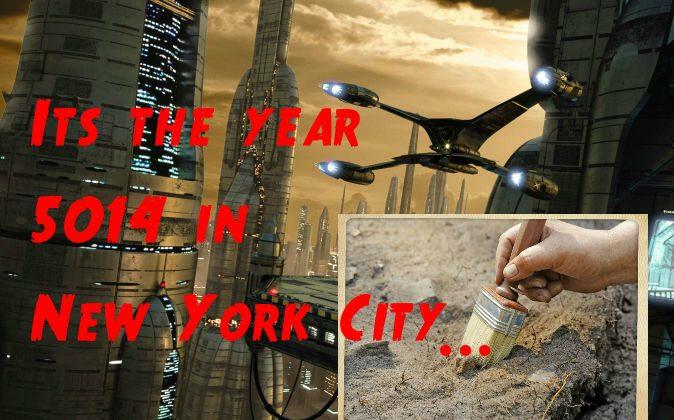Imagine it’s the year 5014 and archaeologists are studying the great ancient civilization of New York City. What might they find? What conclusions could they deduct about today’s society from what they find?
Cornelius Holtorf, professor of archaeology at Linnaeus University in Kalmar, Sweden, came up with some fun, humorous answers to these questions for us. Epoch Times will continue to reach out to archaeologists for various perspectives on these questions.
Epoch Times: What materials would you expect to be left? (For example, today’s archaeologists find stone and metal sculptures, yet objects made of more fragile substances are less likely to have survived. The paint that originally decorated even the more durable materials has worn away. How will our synthetic materials hold up? Are structures and daily objects made less durable?)
Holtorf: Archaeologists in 5014 will encounter a thick layer of 3,000 year old concrete rubble including bits of metal, stone, and plastic. Some parts have been hermetically covered by soil containing clay; in those parts even organic materials are preserved. Among the most interesting finds are banana skins some of which still feature remains of little printed paper labels like these:

Epoch Times: What objects would give you the greatest clues as to how our political systems work? What may the archaeologists deduce (correctly or incorrectly) from these objects?
Holtorf: Specialists agree that these labels mention the names of some of the leading countries of the 21st century (Colombia, Ecuador, Costa Rica, Dominican Republic, Panama), political titles and bodies (consul, control union), and some of its leading politicians (Dole, Uncle Tuca). The archaeologists would therefore infer that bananas were a status symbol at the time. The highest rulers were, during official ceremonies, always holding a banana in their hand.
Epoch Times: What objects would give you the greatest clues as to our culture (arts, social values)? What may the archaeologists deduce from these objects?
Holtorf: The banana labels also mention cultural values (friendly, organic, naturally good, original) and social distinctions (premium, selection, golden). One label even mentioned the name of a popular software archaeologists have found mentioned on other objects (Excel). Another label mentions the title of a famous song (Chiquitita), although some archaeologists are still arguing whether the different spelling is significant. So, on the whole, the archaeologists would get a pretty good picture of what life in the 21st century was like.
Epoch Times: What gaps would be left in history due to the digital nature of our society? (Today’s archaeologists find tangible records in the form of stone tablets, scrolls, et cetera, whereas much of our information is stored in electronic servers)
Holtorf: Archaeologists in the year 5014 know that your assumption is not true as it turns out that many email messages got printed out and are preserved in very extensive paper-based archives (although some parts are badly preserved). A group of forensic archaeologists recently found a way to recover loads more previously unknown electronic documents from storage devices such as discs and cards of various sizes. The 21st century will be known as the Information Age, as so much information will have been preserved about it.
Epoch Times: What methods might you use to date objects? (Imagine even in general or vague terms in what direction dating methods may develop with continual advancements in technology and understanding)
Holtorf: There will be various methods deriving from the natural sciences. However, since 5012 a group of archaeologists has been pioneering a new method of dating small artifacts based on their taste. The validity of the method is not fully accepted yet and more testing needs to be done.
Epoch Times: What would pose the greatest challenge in understanding how we live? Is there anything about our lifestyle that could seem especially perplexing or mysterious to a distant culture that can only piece it together from sparse artifacts?

Holtorf: The greatest challenge for archaeologists in 5014 is the question from which political post Onkel Tuca actually exerted his vast political influence. Some young and radical archaeologist doubt whether he really existed or maybe was a cover for somebody else (Dole?).
Follow @TaraMacIsaac on Twitter, visit the Epoch Times Beyond Science page on Facebook, and subscribe to the Beyond Science newsletter to continue exploring the new frontiers of science!
*Image of an archaeological dig via Shutterstock






Friends Read Free